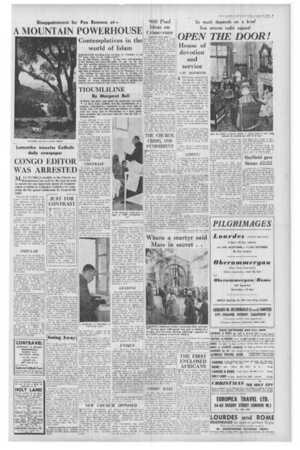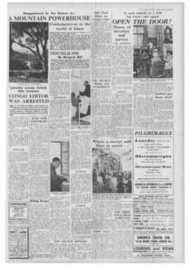Page 5, 19th August 1960
Page 5

Report an error
Noticed an error on this page?If you've noticed an error in this article please click here to report it.
Tags
Share
Related articles
The Priest Who Founded Tioumliline Pere Peyriguere
Monastery For Kerala
Tribute To Bede Griffiths
In A Few Words By Jotter
Foreign Missions Number
TIOUMLILINE
By Margaret Bull
THOSE who know and admire the personality and work
of Dom Bede Griffiths and his establishment of a religious, contemplative, community in the lovely hills of Kerala, may well turn their eyes and interest to a similar work now being done by Benedictines in a place much more accessihle and even more attractive than the hills of Southern India.
I am referring to a house founded in 1952 high up in the mountains of the middle Atlas in Morocco near the Berber capital, Azrou, where the French have established their principal Berber College. Azrou is at the apex of an almost equilateral triangle based on the historic city of Meknes and the far more interesting and historic city of Fez. a holy city containing the tomb of Multi Idriss who first planted the Moslem religion in Morocco and which has been throughout the centuries, with its Qeruwyn University, the centre of the country's traditional culture and learning.
CONTRAST
To arrive at Azrou one rises high on to a plateau from which one gazes down onto an immense valley with the Heights of the Middle Atlas above — then one descends to the town which itself is 4.000 feet high. Immediately above it are woods which in some three miles take one up another 1.500 feet and there one finds a space of comparative level where in the days of the French occupation (which abruptly ceased in 1956) there had been a little school for the sons of officers.
It is this mountain school 5,500 feet up which was chosen for a new Benedictine foundation.
Although it is like all Benedictine houses centred on the liturgy and it is especially one of those Benedictine houses which hopes by contemplation to approach an oiental people, it is in other ways a contrast to what Dom. Bede is doing in Kerala. It is neither the enterprise of one or two pioneers nor does it hope to take over the religious tradition of the people among whom it is placed.
Dom. Bede lives as much as possible like a Sanyasi so as to adapt the Benedictine tradition to the mentality and tradition of the ancient Hindu Piety.
Tioumliline hopes, it is true, to make a bridge leading to the sympathy of Islam, but it is a Community which has not materially altered the mind or mentality it brought with it from France. This community of some thirty monks had already been professed at En-Calcite the great new Benedictine Abbey near Toulouse. There vocations had been so numerous that they could allow a swarm to fly off to a new hive. They arrived therefore with their habits formed, their training complete, because the Archbishop of Rabat felt that there was a great need in Morocco for a retreat house and for the strength which is added to the Catholic life of a country from a house of Contemplatives with that enterprise and initiative which have always flowered out from the liturgical life. The Archbishop had within his jurisdiction one remarkable hermit priest Pere Peyriguere who had gone to live some sixty miles away from Azrou at a village high in the Middle Atlas. In the thirty At the dispensary which gives as many as 15,000 consultations a
year.
years he lived among them he won their confidence and became their counsellor, The Archbishop saw that if he could enlarge this work into that of a Benedictine Community it would provide not only a centre where French clergy and laity could renew their inner life it would also be a centre at the permanent disposal of Moroccans. He was not wrong. Almost immediately it attracted crowds of young Moors who at that time were feeling anything but enthusiastic at the repressive policy of the French; these under the name of a Protectorate were aiming at what some of them called cosovereignty but which was really
thinly veiled annexation.
At Tioumliline Moroccans found w a type of Frenchman who could understand the justice of their claims, and they crowded there for sympathy and counsel. Very soon the Community had founded an orphanage and a dispensary which now gives as many as 15,000 consultations a year!
LEADING
The monastery has in eight years also become a national institution. It fulfils, as nothing else does so well, the ambition of the King and of those near him to make Morocco a centre where East and West, Christian and Moslem. can meet to make friends. Irliernational conferences are held at Tioumliline. Celebrities from America, Paris and Egypt have joined in its discussions. At one of these Conferences the Heir Apparent spoke, at another the Foreign Minister, at another the President of the National Assembly. The Monastery has come to occupy a leading place in the intellectual life of the country. "There," said Jean LacoutOre, the Frenchman who has written best on the Morocco and on the Egypt of today, is the best place to see into the minds of the country,
UNIQUE
As a Monastery Tioumliline is achitecturally unique. The home for monks is a separate building from the chapel and that in turn is some distance from the guesthouse. which is separated from the dispensary the orphanage and the lecture rooms. These one storey buildings are separated from one another by trees and gardens. Around them are the woods, below the sweeps of the mighty valley. The site is superb in a country which those who know Africa find the most attractive in the Continent both for its climate, the splendid mountain scenery, the noble cities, and above all for the fine personalities and warm courtesy of its people. whose elite have a special affinity for Catholic culture.
More's the pity that Pax Romana has had to withdraw their conference from Tioumliline.
blog comments powered by Disqus









